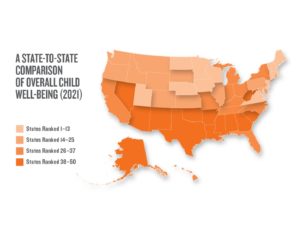4 State-Specific Factors That Affect a Child’s Wellbeing

What does a child need to thrive? Most people know that children need shelter, food and love to be happy and healthy, but there’s more to consider. Overall child wellbeing can be affected by the child’s own personality and those around them like their family and community. But larger systemic trends in a child’s home state also have a direct impact on their wellbeing.
The 2021 KIDS COUNT® DATA BOOK from the Annie E. Casey Foundation, an annual study of children across the United States, measures state-specific factors at play in determining overall wellbeing. The data compiled provides great insight into the overall health and wellness of children, explaining a variety of factors that affect children differently depending on where they live. This latest edition includes data about how families have fared as the global Covid-19 pandemic disrupted everyone’s lives.
Armed with this information, organizations like KVC can understand the different challenges families and children may be facing. Legislators can make informed decisions about policy. And individuals can also use this data to be informed on ways to donate, volunteer, or get more involved in improving the lives of kids in their community.
Would you like to receive inspiring stories and helpful updates from KVC experts once a month? Subscribe to our newsletter here!
What Contributes to Child Wellbeing?
The KIDS COUNT Data Book looks specifically at four domains to measure overall child wellbeing: economic, education, health and family/community factors. Looking at these four categories provides a closer look at child wellbeing, highlighting bright spots in states as well as areas with room for improvement.
The study looks at four “key indicators” within each category, showing how measurements contribute to the overall picture of how a state is doing.
Here are the 16 key indicators of child wellbeing:
- Economic factors
- Children in poverty
- Children whose parents lack secure employment
- Children living in households with a high housing cost burden
- Teens not in school and not working
- Education factors
- Young children not in school (ages 3 & 4)
- Fourth graders not proficient in reading
- Eighth graders not proficient in math
- High school students not graduating on time
- Health factors
- Low birth-weight babies
- Children without health insurance
- Child and teen deaths per 10,000
- Children and teens who are overweight or obese (ages 10-17)
- Family and Community factors
- Children in single-parent families
- Children in families where the household head lacks a high school diploma
- Children living in high poverty areas
- Teen births per 1,000
The Impact of Economics, Education, Health, Family Life and Racial Inequity
Economic wellbeing of a state, determined by factors like availability of affordable housing and rate of unemployment, contributes to how well parents are able to support their children. According to the data, “growing up in poverty is one of the greatest threats to healthy child development.” When a child grows up in poverty, they have an increased risk of experiencing negative impacts to their brain development, negative health outcomes and poor performance in school. Some of the most life-altering impacts of growing up in poverty are the increased likelihood of teen pregnancy and failure to graduate from high school, both of which have lasting economic consequences.
 Having both access to and a high quality of education plays a large role in determining outcomes for kids. With a strong foundation during the elementary years, kids are more prepared for, and more likely to make, post-secondary plans, including which college they might attend and what jobs they might get as adults. Early in a child’s life is a critical time to set a foundation for successful learning. A good education leads to finishing high school and achieving a college degree. Both of these correlate with higher income and success levels. It also allows kids to “successfully transition to adulthood,” as stated in the 2021 KIDS COUNT Data Book.
Having both access to and a high quality of education plays a large role in determining outcomes for kids. With a strong foundation during the elementary years, kids are more prepared for, and more likely to make, post-secondary plans, including which college they might attend and what jobs they might get as adults. Early in a child’s life is a critical time to set a foundation for successful learning. A good education leads to finishing high school and achieving a college degree. Both of these correlate with higher income and success levels. It also allows kids to “successfully transition to adulthood,” as stated in the 2021 KIDS COUNT Data Book.
Healthcare is similar to education in that it is important that kids have both access and quality. Healthcare is a fundamental part of overall child wellbeing and development. It includes not just doctor or dentist visits, but attention to nutrition and their psychological health as well. The KIDS COUNT Data Book mentions, “exposure to violence, family stress, inadequate housing, lack of preventive health care, poor nutrition, poverty and substance abuse” as direct factors in undermining a child’s health. When a child has good health, they are likely to have better outcomes in school and beyond.
Families and communities also impact children in a vital way. This category is close to our heart at KVC, given the work we do to strengthen families and build relationships with kids to help them thrive. We know that children develop the best in loving families, with supportive and trusting relationships to help them learn and grow. When children suffer abuse or maltreatment within their families, they are more likely to experience mood disorders, do poorly in school, and even commit suicide. Children’s wellbeing is greatly improved when they have parents committed to their success, and when they live in communities with strong institutions, good schools and effective support services.
Racial inequities continue to be a factor present in all states and across all domains. According to the study, “the nation’s racial inequities remain deep, systemic and stubbornly persistent. Data suggest that we as a nation fail to provide children of color with the opportunities and support they need to thrive.”
How Does Your State Rank?
The 2021 Data Book shows improvement nationally on 11 of 16 indicators over the last decade. The top ten states for overall child wellbeing are Massachusetts, New Hampshire, Minnesota, Vermont, Utah, New Jersey, Nebraska, Connecticut, Iowa and Wisconsin. Regionally, the Northeast has the most states with high rankings in wellbeing. Appalachian and Southern states have the lowest ranking. The bottom 17 states (besides Alaska) in the rankings can be found in these regions.
View the full list of state rankings here.
How is KVC Working to Improve Children’s Overall Wellbeing?
KVC Health Systems has a long history of strengthening families, developing parenting skills, and equipping families to prevent the need for foster care. Often, it is factors like poor economic resources or lack of access to healthcare that leads families to struggle. But we know that any type of disruption can greatly impact a child. One of our services across our entire network is in-home family support, which aims to ensure that families have the skills needed to safely care for their children, help parents find jobs where they can earn a suitable wage, and work with them to access healthcare.
If foster care is needed so that families can overcome obstacles like substance use, incarceration, abuse or neglect, we work to ensure that children are safe and can securely reunite with their families in as short a time as safely possible. We work with foster families, training and guiding them to provide the best possible home for children who have come to live with them.
With the passing of the Family First Prevention Services Act that became law in 2018, federal funding was made available aimed at keeping children with their families and supporting programs that prevent the need for foster care. KVC supports policies that impact families and children’s overall wellbeing so that they can be happy, healthy and safely together. Learn more about how we’re working to help children and teens in Kansas, West Virginia, Kentucky, Missouri and Nebraska here.
Related articles:







